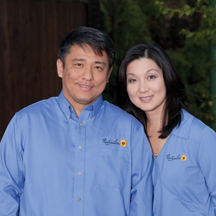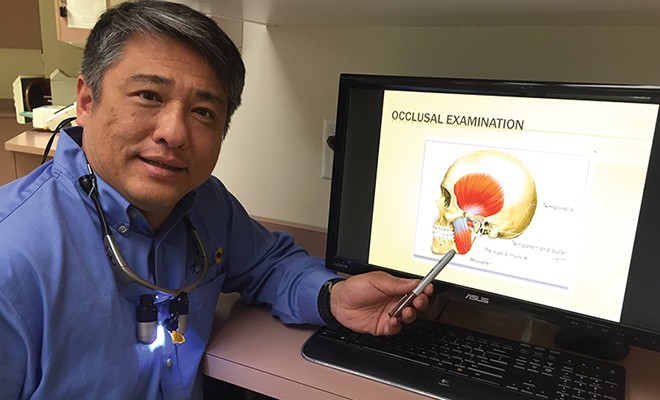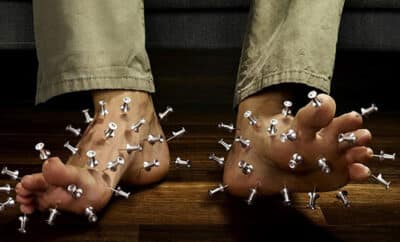What do facial pain, headaches and bad taste have in common with NICO?
 By Dr. Grace Liu and Dr. Lewis Yu
By Dr. Grace Liu and Dr. Lewis Yu
Few dental patients have heard the term NICO, (Neuralgia Inducing Cavitational Osteonecrosis) much less its effect. While most equate the term neuralgia with pain, the other terms, cavitation and osteonecrosis, and their relationship bear explanation.
Cavity and cavitation come from the same root word, meaning hole. A cavity is a hole in the tooth, whereas a cavitation is a hole in a bone. Cavitations can occur in all bones that have bone marrow. Osteonecrosis translates to the death of a bone caused by lack of blood flow to it.
While cavitations may linger for years without producing pain, some produce trigeminal pain. The trigeminal nerve provides sensation to the face and helps control jaw movement. Sometimes when people describe headaches, they are actually describing facial pain. While there are a number of different types of facial pain syndromes, the most common one is trigeminal neuralgia.
Unlike teeth, bone cavitations can’t be detected by simply looking at the bone, and even using x-rays, many are missed. This disease process, which produces osteonecrosis, is actually a progressive impairment that produces small blockages of the tiny blood vessels in the jawbones, resulting in areas of dead bone.
Many researchers today believe that NICO lesions are the focus of various infections which may spread throughout the body. In the last few years, some of the most surprising medical news has been the discovery that bacteria from the mouth may cause various heart, liver and kidney problems.
If you have a joint implant or mitral valve prolapse, your dentist must prescribe an antibiotic before any dental treatment because bacteria from the mouth can spread through the blood to cause serious problems elsewhere in the body.
Initiating factors for NICO are dental trauma, which produces physical, bacterial, and toxic components causing tooth extractions, periodontal disease, cysts, root canal toxins and abscesses. The traditional treatment for NICO cavitational lesions is surgical removal of the dead bone area. The surgery basically consists of making an incision, exposing the bony defects, and scraping them clean (termed debridement) to remove all unhealthy bone and other pathological problems like abscesses and cysts.
It’s not sufficient to simply punch a hole in the bone and rinse the area out, like some doctors recommend. In fact, treating these expanding bony lesions in such a conservative fashion often makes the lesion and subsequent pain much worse.
After removing the dead bone and other pathological products, the goal in healing is bone regeneration. But first, if possible, we remove all predisposing and risk factors.
Ozone Dentistry
Another less invasive course of treatment is ozone therapy. Ozone is an activated, excited form of oxygen that drives oxygen beneath the surface of a tooth through the tubules, obliterating anaerobic bacteria that cause decay.
It essentially starts a process that removes bacterial waste products, halts dental cavities, and begins a secondary process of repair via accelerated remineralization. Ozone not only kills the acid-making bacteria, it also neutralizes their acidic waste. This creates a new environment that is hostile to the bad pathogens.
A new environment allows healthier bacteria to replace the bad ones. If we just kill off the bacteria, they’re back in weeks. But if we get rid of their acid niche, they are gone for two to three months. Ozone treatments at this interval holds the promise of keeping tooth decay away indefinitely.
If you think you have the symptoms of a NICO lesion, and are experiencing pain, don’t allow anyone to operate without first proving where your pain originates. This is done most effectively by closely evaluating x-rays and using diagnostic anesthetic injections to actually turn-off the suspected NICO areas to see if the pain is turned-off.
There are characteristic referred pain patterns of NICO lesions and there are also characteristic responses to local anesthetic testing. Find a doctor who knows about these characteristic patterns and realize that most doctors who treat orofacial and TMJ pain know little or nothing about NICO lesions.
Dr. Lewis Yu specializes in neuromuscular dentistry and in the holistic causes of pain and disease in the oral cavity. He earned his dental degree from the University of Pennsylvania School of Dentistry in 1996. He received two years of advanced post-graduate oral surgery training in both the New York City Hospital System and the Hospital of the University of Pennsylvania. He continues his education through extensive hands-on training at the prestigious Las Vegas Institute for Advanced Studies and the Pankey Institute. The Las Vegas Institute has provided Dr. Yu with advanced training in Neuromuscular Dentistry and Comprehensive Aesthetic Restorations. He had practiced in Philadelphia and Newark, Del., before joining All About Smiles, P.A. and is a member of the Delaware State Dental Society, American Dental Association, and the Academy of General Dentistry.
Dr. Grace Liu has been practicing dentistry since 1996, having earned her degree from the New York University School of Dentistry. She continued her education through post-graduate studies at Columbia University, the Las Vegas Institute for Advanced Studies in Nevada and the Academy of Dentistry. She is also a member of the Delaware State Dental Society, American Dental Association, and the Academy of General Dentistry.







